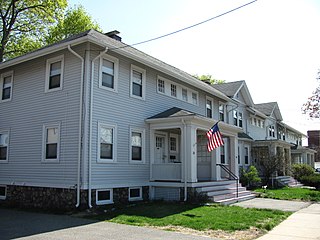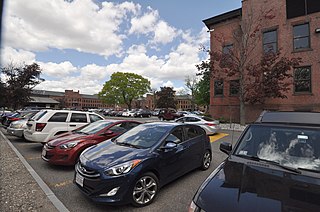
The West Newton Village Center Historic District encompasses the heart of the village of West Newton, in the city of Newton, Massachusetts in the United States. It extends along Washington Street between Lucas Court in the west and Davis Court in the east, and includes a few properties on immediately adjacent side streets, including Watertown Street and Waltham Street. The village is the second-largest of Newton's commercial centers and is the best-preserved of its late 19th and early 20th century village centers. The district was listed on the National Register of Historic Places in 1990.

The Danielson Main Street Historic District encompasses the historic late 19th-century commercial business district of the borough of Danielson in the town of Killingly, Connecticut. It extends along Main Street, between the Five Mile River and Spring Street, including a few buildings on adjacent side streets, representing the area's growth as a commercial and civic center in the late 19th and early 20th centuries. It was listed on the National Register of Historic Places in 1992.

The Lunenburg Historic District is a historic district encompassing the historic center of Lunenburg, Massachusetts. The district is centered on a stretch of Main Street which connects two triangular intersections. It includes many of the town's oldest buildings, including the c. 1724 Cushing House, and the c. 1730 Stillman Stone House. Three of the town's most significant institutional buildings were built before 1850: the town hall, the Congregational church, and the Methodist church. The district was added to the National Register of Historic Places in 1988.

The Petersham Common Historic District encompasses the historic town center of Petersham, Massachusetts. Laid out in 1733 and centered on the town common bounded by Main and Common Streets, it retains most of its 19th-century character, with only a few turn-of-the-20th-century civic buildings adding later character. The district was added to the National Register of Historic Places in 1982.

The State Armory is a historic armory building at 29 Howard Street in Springfield, Massachusetts. Built in 1895, it is a prominent and distinctive example of Gothic architecture in the city's downtown. The building was the first that was purpose-built for the local militia, and was in its later years home to the South End Community Center. It was listed on the National Register of Historic Places in 1976. It was extensively damaged by the Greater Springfield tornado on June 1, 2011, in which the rear drill shed of the building was reduced to rubble.

The Old Hose House is a historic fire house in Reading, Massachusetts. The Colonial Revival wood-frame building was constructed in 1902 for a cost of $1,180.50, plus $10 for the land on which it stands. The modestly-scaled building housed a fire truck until 1930, after which time it has served as home to community groups. The building was listed on the National Register of Historic Places in 1984.

The building at 38–48 Richardson Avenue is a historic residential rowhouse in Wakefield, Massachusetts. Built c. 1912, is believed to be one of the oldest rowhouses in the town. They were built by Solon O. Richardson, Jr., on a portion of his family's estate. The building was listed on the National Register of Historic Places in 1989.

The buildings at 35–37 Richardson Avenue are historic rowhouses in Wakefield, Massachusetts. These two rowhouses, built c. 1912–15, are among the earliest apartment blocks built in the town. They were built by Solon O. Richardson, Jr. on a portion of his estate. The buildings were listed on the National Register of Historic Places in 1989.

The Company F State Armory, also known as the Waltham State Armory, is a historic armory building at Curtis and Sharon Streets in Waltham, Massachusetts. Built in 1908, it is locally notable for its Georgian Revival architecture, and as the city's only armory building. It was among the last of the state's armories to be built to individualized architectural design. The building was listed on the National Register of Historic Places in 1989. The building is vacant.

The House at 380 Albion Street in Wakefield, Massachusetts is one of the finest Bungalow/Craftsman style houses in the town. It was built c. 1910 in a then-rural part of Wakefield that been annexed from Stoneham in the 1880s. The house was listed on the National Register of Historic Places in 1989.

The Dr. S. O. Richardson House is a historic house at 694 Main Street in Wakefield, Massachusetts, United States. Built in the late 1830s, this wood-frame house is one of the finest Greek Revival houses in Wakefield, and was the home of Dr. Solon O. Richardson, a locally prominent physician and real estate developer. The house was listed on the National Register of Historic Places in 1989.

The United States Post Office–Wakefield Main is a historic post office building at 321 Main Street in Wakefield, Massachusetts. Built in 1936 as part of a Depression-era works project, it is a Classical Revival structure that harmonizes with its neighbors. The building was listed on the National Register of Historic Places in 1987, and included in the Common District in 1990.

The Wakefield Trust Company is a historic commercial building at 371 Main Street in Wakefield, Massachusetts. Built in 1924, it is one of three buildings on the west side of Main Street that give the town center a strong Classical Revival flavor. The building was listed on the National Register of Historic Places in 1989.

The West Ward School is a historic school at 39 Prospect Street in Wakefield, Massachusetts. Built in 1847, it is the only surviving Greek Revival schoolhouse in the town. The building was listed on the National Register of Historic Places in 1989. It is now maintained by the local historical society as a museum property.

Hartwell and Richardson was a Boston, Massachusetts architectural firm established in 1881, by Henry Walker Hartwell (1833–1919) and William Cummings Richardson (1854–1935). The firm contributed significantly to the current building stock and architecture of the greater Boston area. Many of its buildings are listed on the National Register of Historic Places.

The Waterford Historic District encompasses the well-preserved historic town center, also known as Waterford Flat, of the rural inland town of Waterford, Maine. Settled in 1775, the town grew around a site where Kedar Brook empties into Keoka Lake. The oldest surviving building, the Lake House, dates to 1797, while most of the houses were built before 1850. Prominent public buildings include a series designed by John Calvin Stevens, including the Knight Library, Wilkins Community Hall, and First Congregational Church. The district was listed on the National Register of Historic Places in 1980.

The Conway Public Library serves the town of Conway, New Hampshire. It is located at 15 Greenwood Avenue in Conway village, in an architecturally distinguished Classical Revival building built in 1900 as a gift to the town from Sarah and Lydia Jenks. The building was listed on the National Register of Historic Places in 2017.

The Federal Square Historic District is a historic district encompassing a portion of the former Springfield Armory in Springfield, Massachusetts. Located across Federal Street from the main Armory grounds, Federal Square was the site of some of armory's early facilities, including a Continental Army magazine during the American Revolutionary War. It was also the site of a brief clash in Shays' Rebellion, in which four rebels were killed. The district was added to the National Register of Historic Places in 2019. It is currently being developed by Springfield Technical Community College as a technology business center.

The St. James Apartments are a historic apartment house at 573 State Street & 5 Oak Street in Springfield, Massachusetts. Built in 1904, it is a good local example of Classical Revival architecture. It was listed on the National Register of Historic Places in 2020.

The Wigglesworth Building is a historic apartment house at 77 Lillian Street and 23 Oak Street in Springfield, Massachusetts. Built in 1917, it is a good local example of Colonial Revival architecture, typifying the city's multiunit construction after the introduction of new building codes. It was listed on the National Register of Historic Places in 2020.























